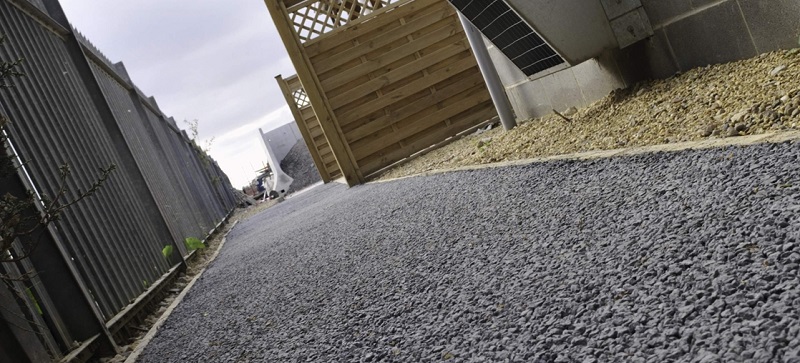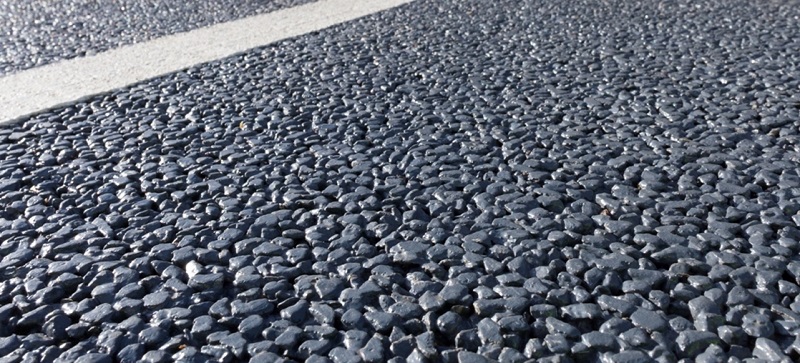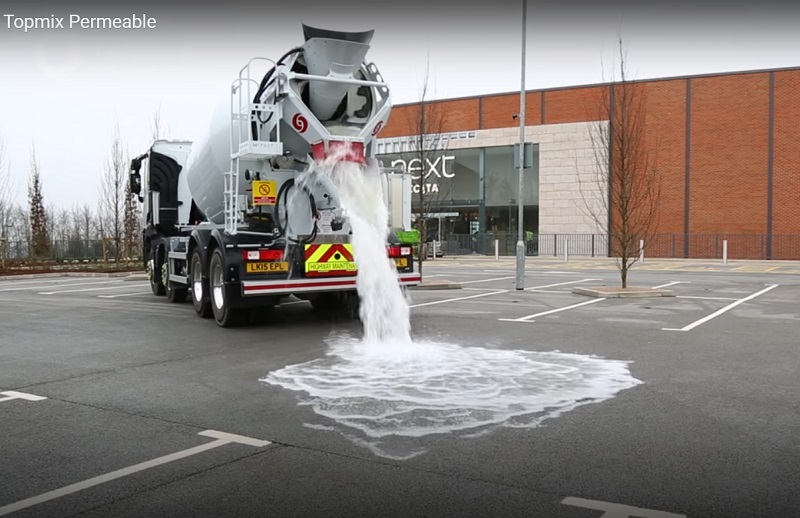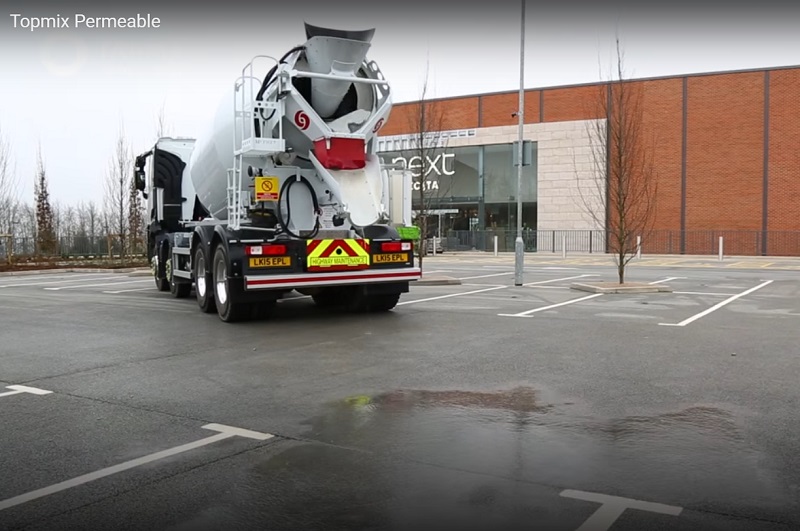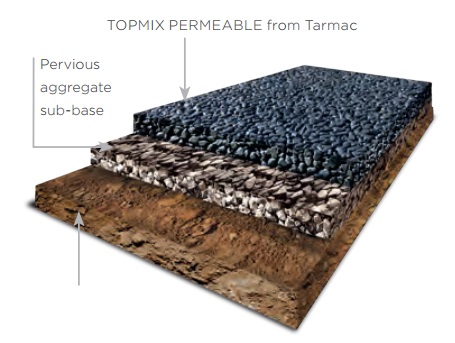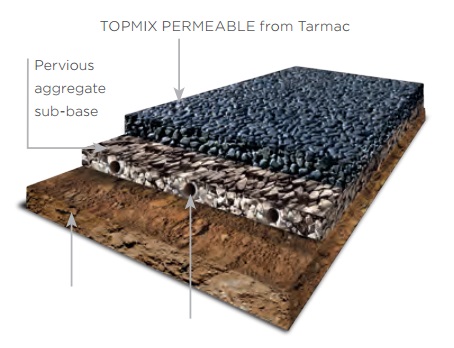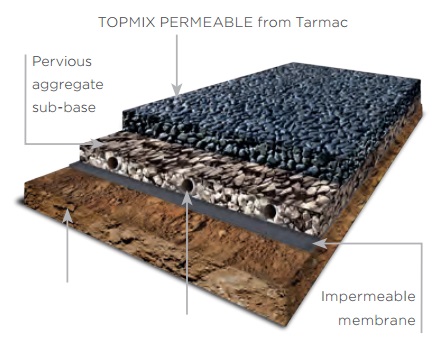Topmix Permeable
Contents |
[edit] Introduction
Topmix Permeable is a fast-draining concrete pavement solution that has been described as ‘thirsty concrete’ because of the rate it is able to absorb surface water.
Traditional concrete must be permeable enough to allow water through to ground level at a minimum rate of 300 mm/hour. By contrast, Topmix Permeable is capable of letting through around 36,000 mm of water/hour.
This innovative new material system, manufactured by Tarmac, offers much potential for the design of sustainable urban drainage systems (SuDS), in terms of being able to provide a practical answer to the perennial problems of surface water flooding.
Whereas conventional concrete is sand-based, Tarmac uses tiny pieces of crushed granite packed together. Known as ‘no-fines concrete’, this has a high void content of 20-35%, and allows surface water to drain through and dissipate naturally. This helps reduce the risk of surface water flooding and watercourse contamination.
Topmix Permeable can be used for a wide range of practical applications, including:
- Low volume residential roads and car parks.
- Pavements, bike and pedestrian pathways.
- Patios.
- Tennis courts.
- Road shoulders.
- Swimming pool decks.
- Alleyways.
- Driveways.
- Greenhouse floors.
- Pavement edge drains and gutters.
- Sports facilities.
- Below permeable blocks for ground stabilisation.
Applications where Topmix Permeable is not suitable include:
- Heavy goods vehicle delivery routes for shops.
- Access to car park ticket barriers.
- Tight turning areas in industrial yards.
- Bus routes.
- Areas with heavy silt loads, such as recycling centres.
[edit] System options
When constructing a pervious paving solution, Topmix Permeable offers three best practice applications that can be employed.
[edit] System A – Full infiltration
All water permeates through the surface layer, through the lower pavement courses and into the sub-grade. This system does not discharge any water into traditional drainage systems, but some water may be retained within the pavement before permeating into the sub-grade.
[edit] System B – Partial infiltration
The underlying ground offers some level of permeability and infiltration is acceptable. Outlet pipes are installed within the sub-base layer to allow excess water that cannot penetrate into the existing ground to drain into watercourses, swales, sewers, and so on.
[edit] System C – Full attenuation
This system is typically used where water recycling is required, where water may be contaminated, or where the sub-grade is impermeable. An impermeable membrane is installed above the sub-grade and outlet pipes installed within the sub-base layer. Water can be captured and harvested for use-use in non-potable applications such as irrigation, toilet flushing, and so on.
[edit] Surface durability
[edit] Heavy traffic
Topmix Permeable is scuff-resistant and resistant to softening in hot weather; however, it is recommended that an impermeable surface is used in areas exposed to frequent tight turning circles and sections carrying particularly heavy traffic.
[edit] Freeze-thaw resistance
Water should not be left to settle within the surface structure by an effective permeable pavement system. In this eventuality however, the Topmix Permeable allows freezing water to expand in the voids, providing freeze-thaw resistance. As the system does not contain rebar, it is not at risk of water or chloride attack.
[edit] Surface skid resistance
The skid resistance of Topmix Permeable is comparable to low texture asphalt and concrete typically used in the construction of footpaths and car parks. Therefore, it is suited to low speed applications, typically of less than 30 mph. Additional design consideration us necessary in areas of higher slip risk, such as slopes or where heavy breaking may occur.
[edit] Advantages
There are several benefits offered by Topmix Permeable:
- Rapid water removal ensures more effective storm water management.
- Safer roads are created as there is less standing water and so a reduced risk of hydroplaning.
- There is a reduced risk of flash flooding.
- There is reduced impact on the natural water cycle.
- There are reduced storm water management costs.
- It is a low-maintenance surface.
- No planning permission is required in domestic applications such as driveways.
For more information, see Topmix Permeable.
Images and content courtesy of Tarmac.
[edit] Find out more
[edit] Related articles on Designing Buildings Wiki
Featured articles and news
The benefits of engaging with insulation manufacturers
When considering ground floor constructions.
Lighting Industry endorses Blueprint for Electrification
The Lighting Industry Association fully supports the ECA Blueprint as a timely, urgent call to action.
BSRIA Sentinel Clerk of Works Training Case Study
Strengthening expertise to enhance service delivery with integrated cutting-edge industry knowledge.
Impact report from the Supply Chain Sustainability School
Free sustainability skills, training and support delivered to thousands of UK companies to help cut carbon.
The Building Safety Forum at the Installershow 2025
With speakers confirmed for 24 June as part of Building Safety Week.
The UK’s largest air pollution campaign.
Future Homes Standard, now includes solar, but what else?
Will the new standard, due to in the Autumn, go far enough in terms of performance ?
BSRIA Briefing: Cleaner Air, Better tomorrow
A look back at issues relating to inside and outside air quality, discussed during the BSRIA briefing in 2023.
Restoring Abbotsford's hothouse
Bringing the writer Walter Scott's garden to life.
Reflections on the spending review with CIAT.
Retired firefighter cycles world to raise Grenfell funds
Leaving on 14 June 2025 Stephen will raise money for youth and schools through the Grenfell Foundation.
Key points for construction at a glance with industry reactions.
Functionality, visibility and sustainability
The simpler approach to specification.
Architects, architecture, buildings, and inspiration in film
The close ties between makers and the movies, with our long list of suggested viewing.
SELECT three-point plan for action issued to MSPs
Call for Scottish regulation, green skills and recognition of electrotechnical industry as part of a manifesto for Scottish Parliamentary elections.
UCEM becomes the University of the Built Environment
Major milestone in its 106-year history, follows recent merger with London School of Architecture (LSE).
Professional practical experience for Architects in training
The long process to transform the nature of education and professional practical experience in the Architecture profession following recent reports.






